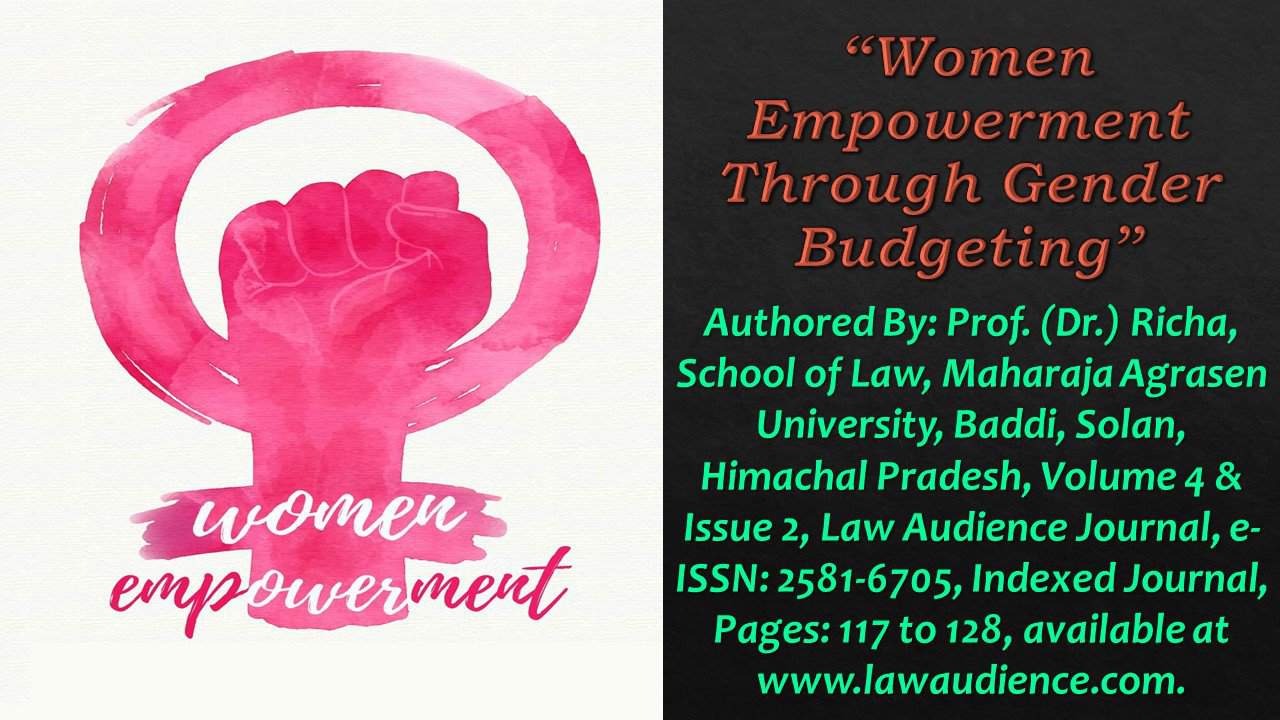Click here to download the full paper (PDF)
Authored By: Prof. (Dr.) Richa, School of Law, Maharaja Agrasen University, Baddi, Solan, Himachal Pradesh,
Click here for Copyright Policy.
I. INTRODUCTION OF INFRASTRUCTURE AND INCLUSIVE PLANNING:
“The infrastructure sector is a key driver for the Indian economy it is highly responsible for propelling India’s overall development and enjoys intense focus from the government for initiating policies that would ensure time bound creation for world class infrastructure in the country. This sector includes power, bridges, dams, roads and urban infrastructure development. Infrastructure is necessary for growth; it provides services that allow society to function and economize to develop from transportation infrastructure to electricity generation, hydropower facilities, water supply, and hygiene network. Infrastructure is thus placed at the center of the efforts to achieve sustainable development goals. With urban areas growing exponentially especially in emerging countries sustainable infrastructure is showing its worth as a more efficient productive and environmentally friendly options. The quality of life within these said urban cities essentially hinges upon the fulfilment of basic needs and access to fundamental infrastructure.[1]
Replacing old urban infrastructure for new modern and sustainable elements will make cities more inhabitable and inclusive this would require a multi trillion-dollar investment worldwide over the next decade but if we do things right it would also see us on the road to economic growth. The Indian government has brought various initiatives towards the enhancement of innovation in infrastructural and industrial sector for the infrastructure sector has become the biggest focus area for the Government of India. Urban planning is a technical and political process that is focused on the development and design of land use and the built environment including air water and the infrastructure passing into and out of urban areas such as transportation, communications and distribution networks and their accessibility. The urban planning has extended to include the inclusive urban planning under its ambit which can be defined as an integrated planning for sustainable resilient accessible, and affordable solutions to the challenges faced by urban poor and vulnerable groups by enhancing their access to urban services and infrastructure through appropriate strategies. It seeks to address issues concerning excess to urban services and the equitability of the urban socio-economic structure by ensuring that all participants have access to the same level of services and opportunities as each other without any gender differentiation”.[2]
II. GENDER BUDGETING AND ITS IMPORTANCE:
The development of a nation lies not only in economic growth but also in the status of its population. Gender equality is a constituent and instrument of development. A country cannot be called developed if half of its population is deprived of its basic needs, livelihood options, access to knowledge and political voice. Women must participate in all aspects of the development process. Gender equality and women empowerment are the key terms that defined and determined the direction of diverse discourses on women, nationally and globally. The Beijing conference was the most significant milestone in the journey towards ensuring gender equality and enriching pragmatic insights into the issues concerning women empowerment. Gender discrimination is pervasive while the degree and forms of inequality may vary; women and girls are deprived of equal access to resources, opportunities and political power in every region of the world.
Gender Budgeting (hereinafter, GB) is a powerful tool for achieving gender mainstreaming to ensure that benefits of development reach women as much as they do to men. It is not an accounting exercise but an ongoing process of keeping a gender perspective in policy/ programme formulation, its implementation and in its review. GB entails dissection of the Government budgets to establish its gender differential impacts and to ensure that gender commitments are translated in to budgetary commitments.[3] The rationale for gender budgeting arises from the recognition of the fact that the national budgets impact men and women differently through the pattern of resource allocation. Women, constitute 48% of India’s population, however, they lag behind men on many social indicators like health, education, economic opportunities, etc. Hence, they warrant special attention due to their vulnerability and lack of access to resources. The way the government budgets allocate resources, has the potential to transform these gender inequalities. In view of this, Gender Budgeting, as a tool for achieving gender mainstreaming, has been propagated.[4]
II.I IMPORTANCE OF GENDER BUDGETING:
The purpose of Gender Budgeting is threefold: to promote accountability and transparency in fiscal planning; to increase gender responsive participation in the budget process, for example by undertaking steps to involve women and men equally in budget preparation; to advance gender equality and women’s rights.[5] Women constitute about half of the population of country; however, they face disparities, inequalities, exploitation and abuse which are adversely affecting their health, nutrition, educational attainment, skills, occupational status, etc. There are a number of gender specific barriers which prevent women from gaining access to their rightful share in the flow of public goods and services. These barriers have roots in prevailing socio-cultural value system, institutional set up and societal structure. Unless these barriers are removed and the felt needs of women are incorporated into the planning and development process, the fruits of economic growth are likely to bypass a large segment of the population of the country.
Eliminating gender discrimination and empowering women are among the paramount challenges facing the world today. Despite the international community’s commitment to gender equality, the lives of millions of women and girls throughout the world are affected by discrimination, disempowerment and poverty. Eliminating gender discrimination and empowering women will require enhancing women’s influence in the key decisions that shape their lives. In India, the plight of women is no better than that of women in other developing countries. Despite the honour and reverence accorded to them as deities in religion and mythology and tribute paid to them as personified in historical monuments, the ground realities have a very different tale to tell. In a patriarchal society like India, there exists the unfounded belief that man is the bread winner of the family. Consequently, the male child gets the best of the limited facilities and resources of the family. The girl child runs the risk of being aborted through the misuse of modern technology of amniocentesis, she is deprived of school education because she has to take care of siblings at home and since she is to be married off soon, and investing in her education is considered generally a liability. Despite the fact that women are massively involved in agriculture, food production and the like, their work remains unrecognized. Their activities as producers are not reflected in statistics thus making their contribution invisible.
Women constitute half of the segment of the population in India and cannot be afforded to be kept out of the mainstream. Secondly, women are vital and productive workers in India’s national economy, and make up 1/3rd. of the labour force. Thirdly, the poorer the family, the greater the dependence on women’s economic productivity. Fourthly, there is a significant gap between women’s potential and actual productivity.
Therefore, women will gain proportionally more if investment allocation and development efforts are shifted in their favour. Fifthly, women’s earnings have a positive correlation with children’s health, nutritional levels and education. The current wave of globalization has greatly improved, in some respects, the lives of women worldwide, particularly in developing country like India. Globalization offers women unprecedented opportunities but equally new and unique challenges. Globalization plays a definite role in increasing opportunities for women in the workforce. The development of technology offers the possibility for women to communicate more directly through networking both within and across countries. However, women remain disadvantaged in many areas of their lives, including education, employment, and health.[6] Gender budgeting has been globally recognized a tool for empowering women by incorporating gender perspective and concerns at all levels and stages of development planning, policies, programmes and delivery mechanism. The Ministry of Women and Child Development, Government of India, as a nodal agency for gendering budgeting, has undertaken several initiatives and has adopted budgeting for gender equity as a mission statement and its widely disseminating tools and strategies across various ministries and departments. Gender budgeting is a methodology to assist governments to integrate a gender perspective into the budget as a key national plan for public expenditure. The national budget impacts women’s lives in several ways. It can directly promote women’s development when funds are allocated for programmes that address women’s economic, social and other needs. This can be done both through funding of mainstream programmes that are delivered in a way that is sensitive to women’s situation, and through funding of women- centric programmes and schemes. The budget can also enhance opportunities for empowerment of women through budgetary allocations.
Gender budgeting is a dissection of the government budget to establish its gender-differential impacts and to translate gender commitments into budgetary commitments. Thus, gender budgeting looks at the government budget from a gender perspective to assess how it addresses the needs of women in the areas like health, nutrition, education, employment, etc. Gender budgeting does not seek to create a separate budget but seeks affirmative action to address specific needs of women. Budgets are reflective of what the government of a country prioritizes? It is a way of enacting government policies that have been identified as addressing the most important issues within the country. Besides looking at revenue and expenditure, budgets need to be understood in terms of a broader context, the process of decision making and with regard to who the participants are in the decision-making process. Gender is an issue that brings to the forefront the reality of inequalities that exist between women and men in the society.
A common reaction regarding “gender” and “women’s issues”, is that they are seen as less important than other problems prevalent in our society, e.g., poverty, unemployment, violence. This dismissive attitude toward gender inequalities is problematic because it denies the reality that those who are most affected are women and in order to address these problems adequately, we need to understand why these problems are gendered. A budget, on the face of it, appears to be a gender-neutral policy instrument. Economists tend to view budgets as gender- neutral instruments since budgets do not mention women or men but consist of financial aggregates. Budgets, however, are not gender neutral, they are “gender blind”. Gender-blind budgets ignore the differing effects on women and men and on different groups of women and men. Gender-blind budgets do not consider that women and men have different roles, responsibilities and capabilities. They ignore the economic and social differences that exist between women and men. A gender budget is a budget that has accounted for the direct and indirect effects of a government’s expenditure allocations and revenues on both women and men.
Thus, a gender budget can also act as an instrument for holding the government accountable to its gender equality commitments. Gender budgets are referred by several names, like, “Gender Budgets”, “Women’s Budgets”, “Gender Sensitive Budgets”, “Gender Responsive Budgets”, “Applied Gender Budget Analysis”, etc. All these terms refer to gender budget initiatives. So, a gender responsive budget is a budget that acknowledges the gender patterns in society and allocates money to implement policies and programmes that will change these patterns in a way that moves towards a more gender equal society. Gender budget initiatives in different names have been undertaken all over globe.
III. ENABLING FACTORS FOR GENDER BUDGETING:[7]
Effective implementation of gender budgeting requires political commitment matched with a technical capacity for gender mainstreaming. Engaged leadership is of particular importance to ensure that gender equality is integrated into the planning and budgeting processes and that public budget revenues and expenditures benefit women and men equally.
- Political will and leadership;
- High-level commitment of public administrative institutions;
- Improved technical capacity of civil servants;
- Civil society involvement;
- Sex-disaggregated data.
IV. GENDER BUDGETING EFFORTS IN INDIA HAVE ENCOMPASSED FOR SEQUENTIAL PHASES:
- Knowledge building and networking,
- Institutionalizing the process;
- Capacity building, and
- Enhancing accountability.
V. SIGNIFICANCE OF GENDER BUDGETING:
Gender gaps persist in education, employment, entrepreneurship and public life opportunities and outcomes. Ender budgeting is a way for governments to promote equality through the budget process. Since every ministry and level of government has a budget, planning the budget with the promotion of gender equality in mind has the potential to help policy-makers address a range of inequalities that have become embedded in public policies and the allocation of resources.[8] Gender budgeting primarily helps to dismantle gender inequalities. Gender inequalities are still visible in the modern society and are clearly demonstrated in entrepreneurship opportunities labour participation remuneration education health outcomes governance and personal representation in top management positions. While these disparities may be associated with traditional aspects especially on the cultural roles of men and women, they demonstrate inequalities in the allocation of public resources.
The purpose of gender budgeting is to remedy such inequalities by ensuring that public policy is designed and delivered in an inclusive manner which recognizes women as key contributors to economic advancement. Gender budgeting require the auditing of public budgets to incorporate the gender differences that are cemented in social systems of reproduction. Public budgets tend to ignore key social reproduction roles such as the maintenance of domestic spaces, human relationships, and bodies which is mostly done by women. The auditing of gender budgets also allows for the visualization of women’s unpaid work of social reproduction and its contribution to the wellbeing of the entire society. Gender equality is not just a fundamental human right: achieving gender equality also brings tremendous socioeconomic benefits. Several studies have shown that reducing gender inequality has many positive effects and leads to higher growth rates, healthier children, improved labour productivity and a more responsive government. Thus, gender responsive budgets, and related policies, will contribute towards achieving gender equality and will simultaneously improve the population’s welfare and lead to more sustainable and inclusive growth and employment.[9]
VI. CORRELATION BETWEEN INCLUSIVE URBAN PLANNING AND GENDER BUDGETING:
Urban planning and design shapes the environment around us and that environment in turn shapes how we leave work play move, and rest. Urban areas are more suitable for heterosexual able-bodied men. They do not take into account either the lives or the needs of women, girls other gender minorities and people with disabilities.
There are six issue areas in the built environment that combines with gender inequity to constrain, inconvenience, and even endangered women girls and other gender minorities of all ages and abilities:[10]
- Mobility – moving around the city safely, easily, and affordably
- Safety and freedom from violence – being free from real and perceived danger in public and private spheres.
- Health and hygiene – leading an active lifestyle that is free from health risks in the built environment.
- Climate resilience – being able to prepare for, respond to, and cope with the immediate and long-term effects of disaster.
- Security of tenure – accessing and owning land and housing to live, work, and build wealth and agency.
Although the World Bank and other institutions are firmly committed to advancing gender equality, oftentimes urban planners, project managers, and practitioners lack awareness of the importance of prioritizing gender in the urban design process, and do not have the specific, on-the-ground knowledge or tools to effectively implement gender-inclusive strategies.
VII. WHAT IS TO BE CALLED A SAFE CITY FOR WOMEN AND GIRLS:
- A city where women and girls can enjoy public places and public life without fear of being assaulted.
- A city where violence is not exercised against women and girls in either the home or the street.
- A city where women and girls are not discriminated against and where their economic social political and cultural rights are guaranteed.
- A city where women and girls participate in making decisions that affect the community in which they live.
- A city where the state guarantees the human rights of all people without excluding women and girls.
- A city where the state and local government takes action to provide attention prevention and punishment for violence against women and girls.
- A city where the state and local government guarantees women and girls access to justice.
A city safe for women is also safe for other week categories that is elderly children disabled. We must focus on making a city that is a place for everyone which means;
- To involve all groups of interest in public participation process;
- A city of short distance should be created and all areas should be easily accessible;
- This security major should be respected and foreseen;
- A city respecting environment and architectural aspect respecting people living there and their healthy lives.
VIII. JAGORI, DELHI BASED NGO, CONDUCTED “SAFE DELHI CAMPAIGN”:[11]
The Delhi based NGO Jagori undertook a study on women safety and initiated the safe Delhi campaign that focused on strategies to create safer environment for women and explored ways to get different groups of people in the city involved. The safety audits were conducted across different spots in the city which were then used to identify the factors that causes the fear as well as a feeling of safety among women. These findings were then to be used for advocacy and encourage the states to include real life inputs and experiences from women in the urban planning process.
IX. PROBLEMS AND PERCEPTIONS FOUND IN THE STUDY:
- Most women felt unsafe going into public spaces alone or after dark unless they were in groups or accompanied by men. Women felt safer in well-lit places so the lighting in public spaces is a major cause of concern.
- Have public transport especially buses are seen as unsafe and are cited by the majority of women as the commonest site for harassment.
- Women felt safer in crowded places then in isolated places. Bus stops are seen as safer since they are seldom deserted.
- Male dominated spaces such as cigarette and pawn shops street corners are felt to be unsafe and are avoided by women especially after dark.
- Women prefer using subways which have vendors and shops.
- Women normally feel safe in using parks in early evenings or around dusk but not after nightfall. Park become almost exclusively male spaces after dark.
X. FINDINGS OF THE SAFETY AUDIT: WE NEED TO FOCUS MORE ON:
- Lightning in public spaces.
- Isolated bus stops.
- Dark roads and unlit streets.
- Parks and green areas.
- Car parking.
- Debris dumps, partially demolished buildings and dark alleys.
- Usable public toilets.
- Male dominated spaces.
- Security guards and police patrolling.
- Market areas.
XI. MOBILITY AND TRANSIT:
Transportation systems are the key to urban life enabling women to access healthcare education and employment opportunities.
For too long women have been ignored in urban transport planning and design. Research suggests that women are more likely to:
- Walk or use less expensive transportation means;
- Use off peak and peripheral public transport routes; and
- Feel unsafe and be at risk of violence while using urban public transport.
XII. GENDER INCLUSIVE URBAN TRANSPORT INCLUDE THE NEED TO:
- Examine the gendered impact of urban transport planning – for example a focus on improving major transport corridors into a city centre is more likely to favour men whereas women benefit more from transport improvements within peripheral areas;
- Design urban transport infrastructure that reflects women’s needs including safety;
- Integrate formal and informal public transport;
- Develop strategies to encourage more women into the urban transport workforce.
XIII. CONCLUSION AND SUGGESTIONS:
- Gender inclusivity in planning cannot be achieved only through the participation and efforts of women but it is possible only through the active involvement of all that is men and women groups, municipalities and the government, international networks and the UN agencies.
- Emphasizing on the major issue of safety and security of women result in creation of positive public spaces which promote them strengthen the level of interactions between people.
- Gender inclusiveness promotes greater participation of all groups and segments of the societies along with improved ease of access to public spaces.
- It is the smaller aspect such as lighting, good transport facilities and urban design techniques that have a significant role in shaping the society as a whole.
Cite this article as:
Prof. (Dr.) Richa, “Women Empowerment Through Gender Budgeting”, Vol.4 & Issue 2, Law Audience Journal (e-ISSN: 2581-6705), Pages 117 to 128 (10th August 2022), available at https://www.lawaudience.com/women-empowerment-through-gender-budgeting/.
Footnotes & References:
[1] Gender Responsive Budgeting for Indian Cities: The Case of Bhopal and Pune. https://journals.sagepub.com/doi/pdf/10.1177/0975425318821806; accessed on 29-01-2022.
[2] http://rcueslucknow.org/publication/TrainingModules/Dr.A.K.Singh/GenderBudgeting.pdf; accessed on 30-01-20022.
[3] Ibid
[4] https://wcd.nic.in/gender-budgeting; accessed on 25-01-2022
[5] https://eige.europa.eu/gender-mainstreaming/methods-tools/gender-budgeting; accessed on 25-01-2022
[6] Supra note 1
[7] https://eige.europa.eu/gender-mainstreaming/methods-tools/gender-budgeting; accessed on 29-01-2022
[8] https://www.oecd.org/gov/budgeting/gender-budgeting.htm; accessed on 30-01-2022.
[9] https://eige.europa.eu/gender-mainstreaming/methods-tools/gender-budgeting#7; accessed on 29-01-2022
[10] https://www.worldbank.org/en/topic/urbandevelopment/publication/handbook-for-gender-inclusive-urban-planning-and-design; accessed on 30-01-2022.
[11] http://www.jagori.org/wp-content/uploads/2006/01/Strategic_Framework.pdf; accessed on 29-01-2022.




